Granite rock faces on the French River
Posts Tagged ‘Northern’
Northern lights play over the USA

Photographers and star-gazers in the upper United States were treated to a rare display of Aurora Borealis when the ‘Earth passed through a region of south-pointing magnetism in the solar wind,’ according to spaceweather.com. More aurorae are expected in the late hours of June 8 or early June 9, with NOAA forecasters estimating a 65% chance of geomagnetic storms. Click through for images and more details.
News: Digital Photography Review (dpreview.com)
The Yukon’s Northern Lights – Behind the Scenes
A guest post by Phil Hart – author of the Shooting Stars eBook (use code DPSTARS for a 25% discount).
My three favourite things in the world are mountains, aurora and snow. In early 2012 I got all three of them in spades when I spent nine weeks in the frozen north of Canada’s Yukon Territory.
With four cameras and dozens of lenses, tripods and a truck full of extreme cold weather gear, I journeyed across the Yukon and chased every gap in the clouds I could find. Three terabytes and a long learning curve later, this video is short, fast and high-impact two minute compilation of some of the best footage I captured during my aurora adventures.
In this post, let me share some of the ‘behind the scenes’ work that went into producing it. First the video, which you really do have to watch in full-screen with the lights down and the music up!
The Yukon’s Northern Lights from Phil Hart on Vimeo.
Camera Gear
Cameras: 2 * Canon 5D Mark II and a Canon 1100D (aka Rebel T3).
Lenses: Canon 24mm f1.4L (I & II) and 14mm f2.8L with the full-frame cameras and Canon 10-22mm f3.5-5.6 and 15-85mm f3.5-5.6 with the cropped sensor camera.
Tripods: Various Manfrotto and Induro tripods with mainly ball-heads. The grease in the Manfrotto heads froze at around -25 ºC (~15 ºF) but were still workable.
Remote Releases: I was using both programmable and simpler push-button cable releases. Most often I simply had the camera in Manual mode, set with a particular aperture, ISO and exposure duration. With the camera set to Continuous Shooting mode (aka Sports mode) I could lock the button down on the cable release and the camera would fire off a long sequence of images with the same setting (and almost no gap in between) until I came back to stop the sequence (or the battery ran flat).
Dew Heaters: Dew is a common problem for night sky photography, but in sub-arctic climates like that in the Yukon, the air is so dry that it is less of a problem (although it forms as frost, not dew with the temperature well below freezing). Some nights when the cameras were running on long sequences, I did need a little protection from frost on the lenses, and was generally using little 2-inch heater straps from from Dew-Not.
Power Supplies: 12 volt lithium-ion batteries to power dew-heaters, motion control (below) and also one of the cameras via a DC-power adapter for long all-night sequences. Lithium-ion is about the only type of widely available battery-chemistry that can cope with extremely cold temperatures. While their capacity did drop, I could still get 1 hour of continuous operation out of my Canon 5D Mark II even at temperatures down to -40 degrees and a very respectable 2 hours at milder temperatures of -15 ºC (~0 ºF).

Setting Up Gear in the Cold
Exposure Settings
The aurora can vary enormously in brightness. When it is quiet, it can be as faint or fainter than the Milky Way, requiring 30 seconds with a high ISO setting (~1600-3200) to capture it nicely (like the final aurora sequences in the video). However, when it is bright it can be as bright as the Full Moon. On those few nights of the greatest aurora storms (like the two main sequences in the video), exposures of just 2-4 seconds can be enough (still with the aperture wide open and a high ISO).
The other challenge with aurora is how fast it can move. Generally there is a balance here with the brightness. Faint aurora displays are usually also quiet in terms of movement, so longer exposures do not blur out too much of the movement. The fast moving auroras also tend to be bright, and the curtains and rays move rapidly, enough to cause them to blur significantly even in 8-10 second exposures. So it’s important to keep carefully balancing the trade-off in this regard. You get more experienced at this quite quickly, but fast lenses also help a lot, which is why I particularly valued the 24mm f1.4 lenses I was using extensively during this trip for images like this one:

Fast and Bright Aurora: 2 second exposure with 24mm lens at f1.4, ISO3200.
Focus
Focus at night is difficult already, but with timelapse you have the additional complexity of often incorporating some foreground elements without the daytime luxury of stopping the lens down to provide high depth-of-field. In most cases this can be avoided by trying to work with large foreground elements that can be kept a couple of meters away from the camera. Although focus on the stars and the foreground is not perfectly the same, at this distance the difference is not significant enough for most people to notice or object to. The eye is also a lot more forgiving of these kind of compromises in video than it is high with a large format still image.
Motion Control
Vixen Polarie: A compact little mount designed for taking tracked long-exposures of the stars but which can also be easily used as a simple panning mount when the motorized axis is pointed vertically.
Dynamic Perception Stage Zero Dolly: A six-foot long aluminium dolly rail with controller, used to provide the sliding sequences in the video. The LCD screen on this was very difficult to read and slow to update in extreme cold conditions.
Custom controller: Developed jointly with Fred Vanderhaven, this provided pan/tilt motion control and almost fully automated day-to-night twilight exposure control. It was only used for two of the clips in this video and the functionality in that case was similar to the Vixen Polarie.
One of the strongest sequences in the video (as the music really kicks in) has the camera moving in between two trees, with aurora on the left and moonrise on the right. Here is the scene as that sequence was being captured:

Dynamic Perception Dolly in Action
And here is a still from the resulting image sequence:

Still image from sequence captured on Dynamic Perception Dolly as shown in previous image
Image Processing and Video Editing
My workflow for editing timelapse video from the RAW image sequences has improved a lot, but it is still a very time-consuming process. And while I am very experienced at using Lightroom and Photoshop to process astrophotography images, I am still a relative beginner at video editing.
I do the most significant development of the RAW files in Lightroom, choosing one frame that is representative of the sequence and then sync the settings across all the images so that they have the same processing. In some cases, where there is a big change in brightness (which happens a lot with aurora) I use Gunther Wegner’s LRTimelapse software to interpolate development settings between keyframes in the sequence, to cope with large changes.
After saving the settings to the Metadata for the images, I then I import the sequences into Adobe After Effects, and use that to render the sequence of RAW files to a loss-less intermediate video file. One of the most common effects I apply in After Effects is to use the Neat Video noise reduction plug-in. This has a ‘neat’ temporal noise reduction algorithm which compares changes between frames to help reduce noise (which varies between frames) without smearing out real detail (which is constant, but perhaps moving between frames). The Neat Video plug-in makes a significant difference to the quality of the end-result.
The other plug-in that I made some use of is the Granite Bay Deflicker plug-in. This was essential for smoothing out flicker that is present in the evening and morning twilight sequences, and was also used in the moonset clip.
The final video was compiled from the individual sequences using Adobe Premier Pro.
Composition: Reflections and Mountains
Many classic and beautiful images of the northern lights involve reflections in the foreground. The problem for me was that there is very little open water anywhere in the Yukon in the back half of winter, with the temperature having dropped as cold as -40 ºC (~40 ºF). The only place I found was an artificial deep water outlet from Fish Lake, near the capital Whitehorse. The night that I was there the aurora was very quiet but I did manage to capture a short sequence late in the night.

Fish Lake Aurora Reflections
Aside from that, one of my favourite locations was along Annie Lake Road which offered a nice mix of trees, open areas and mountain views as well. In this image, the reflections are in some relatively clean flat ice that had been cleared of snow by wind and some early spring sunshine during the day.

Annie Lake Aurora Reflections in Ice
One of the reasons I was keen to be in the Yukon rather than the even more desolate and flat Northwest Territories (where the weather and aurora prospects may be better) is the more interesting terrain. However, with very few roads and even less open in winter getting access to interesting locations was quite a challenge.
The image below is the most spectacular mountain view I captured (technically in the northern part of British Columbia), looking south from the road between Haines Junction and Haines Alaska. However, except on the biggest storm nights, the aurora was generally viewed to the north. So I never saw aurora over these mountains but they did make for a great sunrise sequences to end the video with. Aside from that, my favourite mountain location was way up north in Tombstone Park, which you can see in the image of ‘fast and bright aurora’ above.

Mountains viewed from the Haines Alaska Road
Music
Timelapse videos without music can still be interesting to watch, but are hardly captivating. Good music brings them alive, although it’s hard to suit everyone’s tastes. There are several online sites offering stock audio clips, but the images and the story flow so much stronger with music that is composed and produced to match the visuals. In this case, I again set my talented friend Dean Roberts (of ‘The Dirt Floor‘) the challenge of recording music for the video. Aside from watching the video the previous day, he recorded and edited the track for this in one (long) day. I hope you enjoy the rockin’ soundtrack he came up with.
If you’ve read this far and not watched the video yet, have a look – I know you’ll enjoy it! And if you’ve got a taste for aurora, you can read more about my adventures in the Yukon and see more videos on my blog: philhart.com/tag/yukon-aurora
Post originally from: Digital Photography Tips.
Check out our more Photography Tips at Photography Tips for Beginners, Portrait Photography Tips and Wedding Photography Tips.
The Yukon’s Northern Lights – Behind the Scenes
South Platte River at Fort Lupton – Northern Colorado Paddling

Paddling upstream with GoPro camera mounted in the front deck.
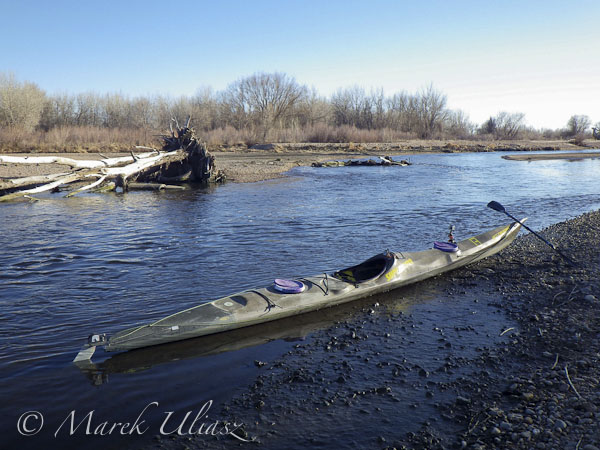
About 2 miles upstream of Fort Lupton. The river was shallow, fast, twisty, stinky … Near perfect! I had a great workout.

Back to Fort Lupton.
I have paddled JKK Supernova starting at Fort Lupton several times this winter. It seems that my driving time from Fort Collins is about 45 minutes and is not longer than driving to Kersey below Greeley. I didn’t try to paddle my SUP since some spots were too shallow for a fin.

This is a diversion dam just below Fort Lupton. I’ve paddled the river between Fort Lupton and the confluence wit St Vrain Creek. There are 7 dams in this short section. Maybe, it’s a time to run it just for documentary purposes, certainly, not for recreation. It feels like a packrafting project.
Related posts:
South Platte River below Denver, Colorado – GPS/photo river guide
Northern lights over Fairbanks, Alaska (October 31, 2011)

Time-lapse movie of the northern lights over Fairbanks, Alaska. (10:42 – 11:22 pm AKDT, October 31, 2011) Camera: Nikon D90 Lens: AF-S NIKKOR 24mm f/1.4G ED Information: 24mm, F/1.4, Manual, 1.3 sec, +0.3EV, ISO3200, Interval: 2 sec, Movie: 10fps. BGM: Roots – Galdson www.jamendo.com License of music creativecommons.org
Video Rating: 5 / 5
Timelapse Northern Lights And Startrails 720p HD
All video footage is copyrighted to me. A storm on the surface of the sun known as a “coronal mass ejection” pushed billions of tons of superheated gas into the solar system, which is now appearing over some parts of the northern hemisphere in the form of aurora borealis. The Telegraph reports: “Dramatic auroras were seen in Denmark, Norway, Greenland, Germany and across the northern United States and Canada” Tuesday night. Watch in HD! 2900+ still images taken with Nikon D40 through a Sigma 10-20mm f4 lens and nikon 35mm f1.8. I used Camera control pro for some clips, but most of them were taken only using the Nikon ML-L3 remote since D40 doesn’t have a built in intervalometer. One clip is taken in Bergen, Norway, the remaining clips are taken in Levanger, Norway. Some aircraft navigation lights and even a few meteors are captured in this timelapse. The star trails effect was created using photoshop and a star trails action which can be found here: timelapseblog.com and downloaded from here: www.mediafire.com Thanks to Owen Scharlotte! Camera: Nikon D40. The soundtrack is Mika: Fall to pieces -Silence, it can be found here: ccmixter.org
Video Rating: 4 / 5
Taking stock of the gear used on a trip is important to help you better pack and plan in future. Today I go through and honestly evaluate what I took, how useful it was, and how often I used each piece of gear. I love going to Cheung Chau – it is a tradition of mine. A few days of relaxation, good food and photography. Check out the map here: g.co Join our new Flickr forum: www.flickr.com www.facebook.com www.mattgranger.com https
Video Rating: 4 / 5
Capturing the Northern Lights in Timelapse Video
A guest post by Phil Hart – author of the Shooting Stars eBook (use code DPSTARS for a 25% discount).
In this post, I’d like to share the back story to a new video I have released after a nine week ‘extreme astronomy’ adventure in the Yukon earlier this year, where I went to capture timelapse footage of the Northern Lights (the ‘Aurora Borealis’).
First the video, ‘Valentine’s Aurora’, which I hope you will enjoy with the lights down and the music up:
Valentine’s Aurora from Phil Hart on Vimeo.
The Location
All of the footage for this video (except the fisheye sequences) was shot on Annie Lake Road, south of Whitehorse the capital of Canada’s Yukon Territory. See this Map Link.
It was the 14th February, and only my second night out on location away from home base where I was staying on the shores of Shallow Bay, Lake Laberge, to the north of Whitehorse. The weather was good during the day and I was confident of clear skies, so I made the trek an hour and a half south. There was nothing to indicate that aurora activity was going to storm that night, but that’s the nature of aurora. When you’re this far north you have to get out whenever the weather is good and capture whatever happens. Further south, you might like to monitor the forecasts on spaceweather.com.
I could actually see aurora curtains low in the north even before the end of twilight, so I had an idea I was in for a great night, and had to get moving quickly.
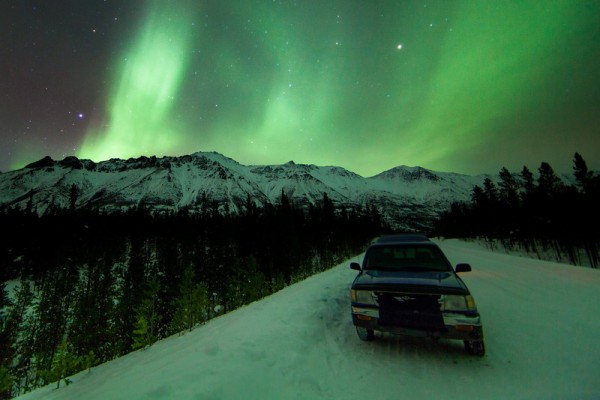
On location at Annie Lake Road: Canon 5D Mark II, 14mm lens, 30 secs, f2.8, ISO800
Camera Gear and Exposure Settings
I used four cameras to capture all the footage in this video:
- Canon 5D Mark II with 24mm f1.4 lens
- Canon 5D Mark II with 14mm f2.8 lens
- Canon 1100D (Rebel T3) with 10-22mm lens
- Canon 5D (original) with Peleng 8mm Fisheye lens (running autonomously with an intervalometer back at Shallow Bay)
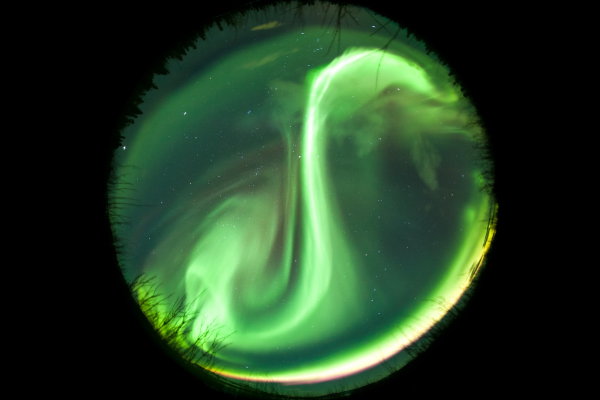
Fisheye Aurora: Canon 5D, 8mm lens, 30 secs, f3.5, ISO800
All of these lenses were used at their maximum aperture, as to capture the motion of the aurora requires exposures that are as short as possible. In general, exposures were ~6-8 seconds with the fast f1.4 lens and ~15-25 seconds with the slower lenses. But when the aurora was very bright and active, I was using exposures as short as ½ second with the f1.4 lens. In fact, there were actually a few minutes that night where I could record live video of the aurora, but that footage was too grainy to use in this compilation.
Although I was recording long timelapse sequences of images very quickly, I still tried whenever possible to capture full size RAW files. Only when the exposures were short (<1 second) was I forced to shoot straight to JPG as the camera could not keep up otherwise. At the end of the nine weeks, I had nearly three terabtyes of data, which is quite a headache!
Motion Control and Accessories
- The 5D Mark II and 24mm lens were carried on an alt-azimuth panning mount with a custom controller, to create some of the panning sequences in the video.
- The 1100D (Rebel T3) with 10-22mm lens was carried on a little Vixen Polarie, used in a horizontal panning mode, which provided for simple panning sequences.
- The other 5D Mark II with 14mm lens was used on a standard tripod.
These last two cameras were set to continuous shooting mode, and a simple push button remote release was used to fire off the shutter for as long as the button was locked down.
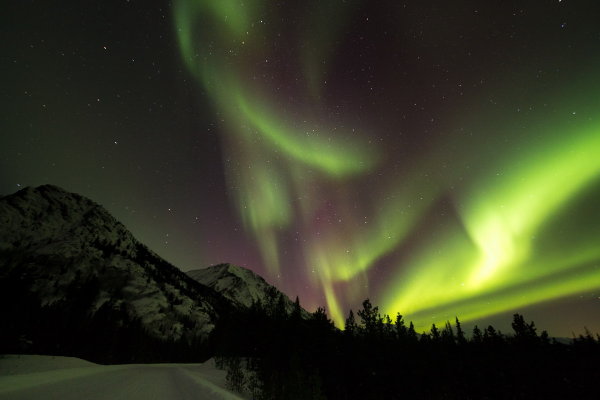
Canon 1100D (Rebel T3), 10-22mm lens @10mm, 25 secs, f3.5, ISO800
Composition
With aurora, like other night sky photography and landscape work in general, it’s the combination of foreground and sky that makes an image. So I spent a lot of time looking for rugged mountains and other attractive foregrounds. But location scouting is quite difficult in the Yukon in the middle of winter, with very few roads open and clear. Despite several more weeks touring around after this, Annie Lake remained one of my favourite locations and it was one of the more accessible as well.
One of the factors to consider when chasing aurora, and one of the advantages of this site, is to look for a low northern horizon to increase visibility when aurora activity is low, but interesting horizons around to the east and west for when activity increases.
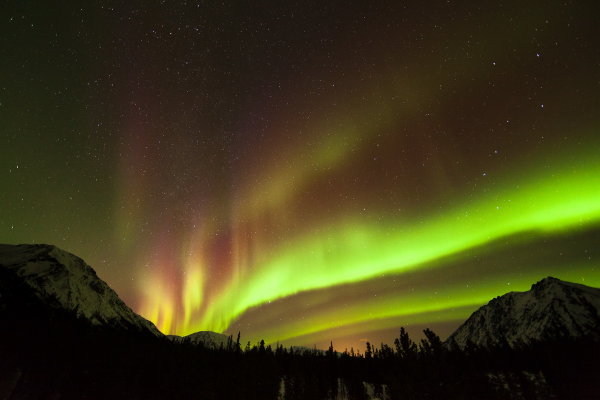
Landscape with low northern horizon: Canon 5D Mark II, 14mm lens, 15 secs, f2.8, ISO1600
Unless you resort to light painting, in general the foreground appears silhouetted against the aurora, so you need strong profiles (isolated trees for example, rather than a wall of them). But occasionally the aurora is so bright overhead that it can actually illuminate the scenery. You can see that in the image below. Other times you may have moonlight which creates a very different lighting environment, and turns the sky blue just like the daytime sky.
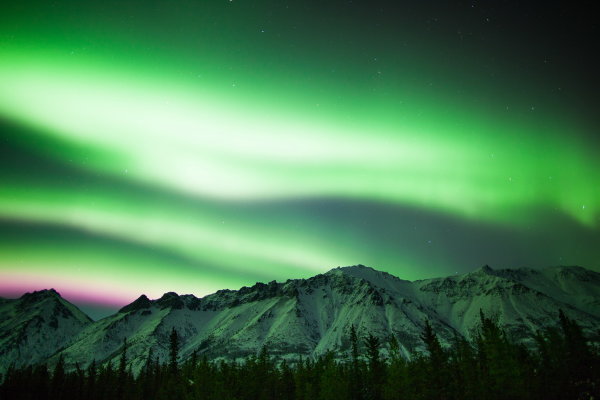
Bright aurora illuminating the landscape: Canon 5D Mark II, 24mm lens, 5 secs, f1.4, ISO800
Post Processing
I learnt a lot as I began to process these Image sequences back home in Melbourne. To get the most out of them, I used Adobe After Effects to directly import the RAW image sequences. I also used the Neat Video noise smoothing plugin to reduce the appearance of noise without sacrificing too much detail. In some cases I also used Lightroom and LR Timelapse to smoothly vary some development parameters across the sequence, to cope with large variations in brightness of the aurora, before importing the sequence into After Effects. These frequent and often fast changes in brightess of the aurora is one reason why I often shot at lower ISO settings (~ISO800) than I normally would for night sky photography, to prevent clipping of bright areas of the aurora as much as possible.
The Star Trail effect at the end of the video was created using the ‘Lighten’ blending mode in the freeware program StarStax by Markus Enzweiler, which I highly recommend.
I hope you enjoy this Valentine’s Aurora video and a little of the behind the scenes story. Feel free to share it!
Post originally from: Digital Photography Tips.
Check out our more Photography Tips at Photography Tips for Beginners, Portrait Photography Tips and Wedding Photography Tips.
Capturing the Northern Lights in Timelapse Video
Article: Auroral photography – A guide to capturing the Northern Lights
 Wilderness photographer Ben Hattenbach advises on how to capture images of the Northern Lights. In this article he explains how to find an aurora and how to equip yourself to photograph it. He also gives advice on camera settings and composition.
Wilderness photographer Ben Hattenbach advises on how to capture images of the Northern Lights. In this article he explains how to find an aurora and how to equip yourself to photograph it. He also gives advice on camera settings and composition.
News: Digital Photography Review (dpreview.com)
You must be logged in to post a comment.